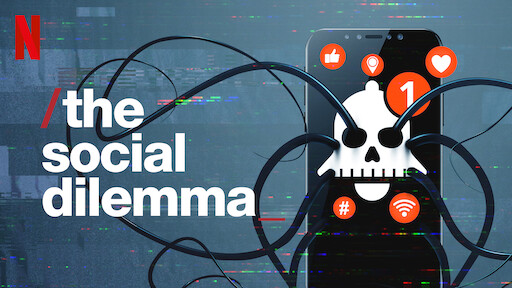The Social Dilemma: Social Media is Turning People into Products

Source: Netflix
October 15, 2020
In the past couple months, Netflix has been loading up lots of interesting new movies and shows. One of their most recent additions is a Netflix Original documentary titled “The Social Dilemma.” The hour-and-a-half long movie explores the deeper, darker aspects of the internet, particularly social media. The film is driven by a series of interviews and anecdotes from different experts and executives of many of the nation’s largest tech companies, including Google, Facebook, Twitter, Firefox, and more. All of the employees mentioned how social media was becoming an outlet for developers and producers to use the actual users as products. A quote from the documentary says, “If you aren’t paying for a product, you are the product.” It then dives into each of the developers’ roles and experiences at the tech companies, and what they had to say about the manipulation on social media, even with the knowledge of the “behind the scenes” scheme. The central idea was that social media has transitioned from being an occasionally used outlet, to an elaborate, addictive ploy for producers to manipulate people for profit.
We all know that social media has seen an exponential increase in users over the past few years. According to Convince and Convert, 79 million Americans used social media in 2019, a rise of almost 800% since 2008. The inception of a variety of new social internet platforms directly correlates to an increase in users, especially among youth. The American Academy of Child and Adolescent Psychiatry (AACAP) finds that 90% of teens ages 13 to17 have used social media, with an average online time of 9 hours per day for that age group. Apps like YouTube, Facebook, Instagram, Pinterest, LinkedIn, Snapchat, Twitter, Whatsapp, and Reddit rank as the most widely used social media platforms among US adults (Pew Research), but newer platforms like Musically/Tik Tok have gained increasing popularity within the younger generation. Such networks create large forums for people all over the world to spread ideas, entertainment, and build connections, especially when the pandemic stripped everyone of most physical connections.
However, it can be easy to overlook the consequences of social media use. I can testify personally that I am very much addicted to my phone. When comparing screen time with my friends and people in my community, I came to the realization that a lot of people my age were spending over 50% of the day on their screens, with a majority of that time being spent on social media. How is it possible for us to be so hooked to a tiny screen for hours on end? As it turns out, advertisers and developers aim to keep people on their websites for as long as they can. “The Social Dilemma” opened my eyes to the marketing strategy that these web producers employ so they can have the most views on their advertisements. The strategy itself is based on a relatively straightforward algorithm, designed specifically to provide only the most appealing content to the viewer. The algorithm utilizes past data based on the user’s preferences—what videos, images, or posts they have liked, commented on, or disliked—and filters the content they view so that they are only seeing what they like to see.
At first glance, this method may seem clever and profitable, but it brings up a multitude of issues. The documentary also talks about the extreme political polarization in the US and how it is largely attributed to the media and fake news. With this algorithm, it is extraordinarily difficult to get unbiased reports and data when trying to research a political problem because media outlets are only going to pull up and suggest information tailored to the viewer’s preferences and opinions. The results of this are evident in the nation currently, where the right and left are more divided than ever, and it almost seems impossible that anyone on either side can understand the reasoning of the other. How would they be able to reason with one another if the media doesn’t even give them the same basis of reasoning or information?
Sadly, the unfortunate truth is that social media developers aren’t going to change this problematic strategy, since it brings in the most money for them. From a monetary standpoint, manipulating human views into products would be a win-win situation for both sides, because people enjoy viewing personalized content on social media and developers profit financially. However, the moral view disagrees with this because the human mind should not be portrayed or treated as a product, as they are sentient beings that are vulnerable to the psychological, physical, and emotional effects of being manipulated. “The Social Dilemma” explores the question: how many human minds are tech developers willing to sacrifice in order to sell their product?
















































































































































